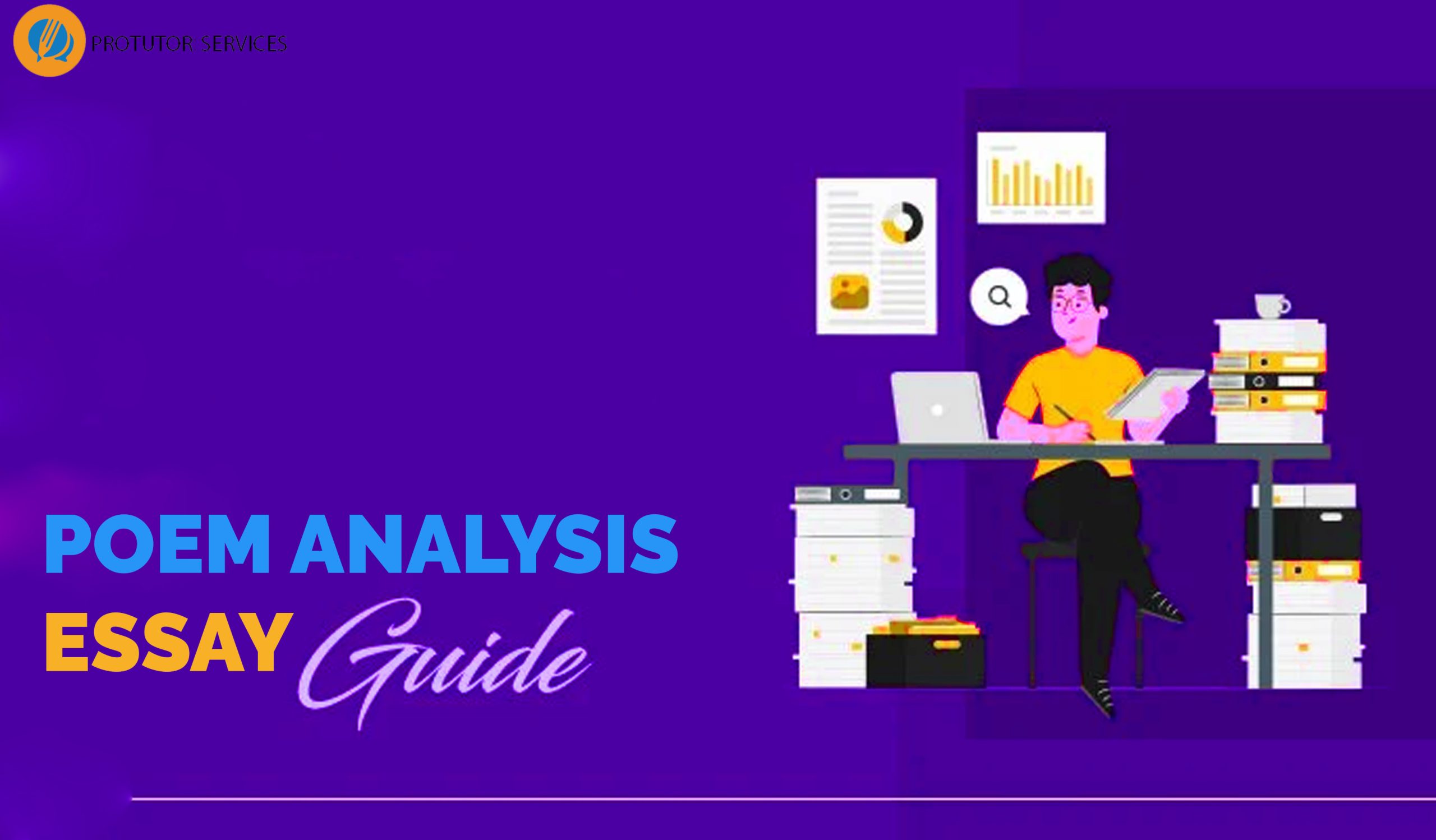APA Format Comprehensive Guide for Students & Researchers
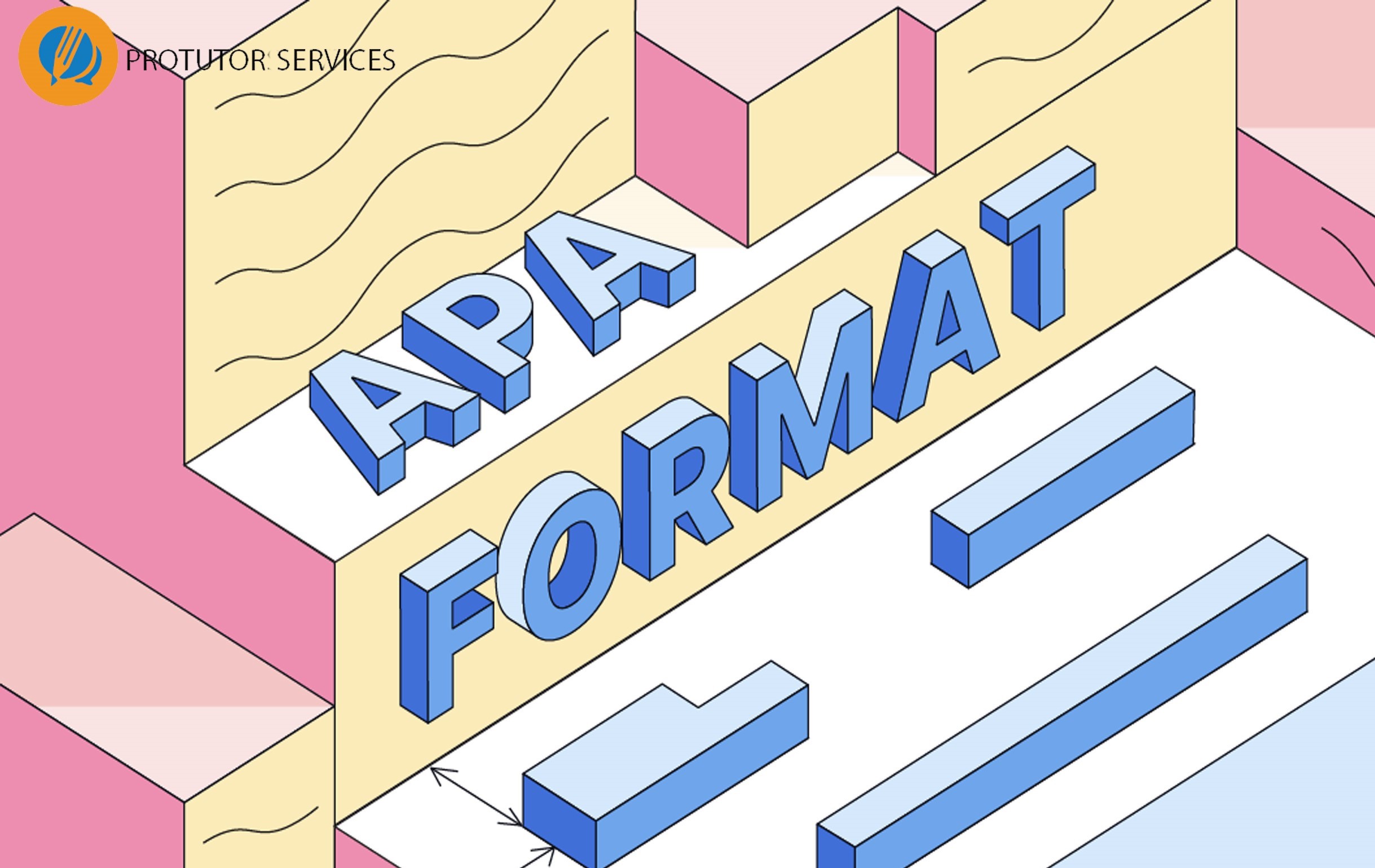
In your studies, you are likely to come across the American Psychological Association or APA format of writing essays. Some subjects that utilize this writing style are the social sciences, including psychology, anthropology, and sociology, as well as education and other subjects. In this article, our online helpers will enable you, students and researchers, to learn the fundamentals of formatting a research paper following APA format standards.
We guide you on conceptualizing, planning, and APA citation of your essay’s fundamental elements and gives helpful hints on grammar, spelling, and other writing mechanics. By the end of reading this article you will be in a position to write a comprehensive essay strictly according to the APA format reference style.
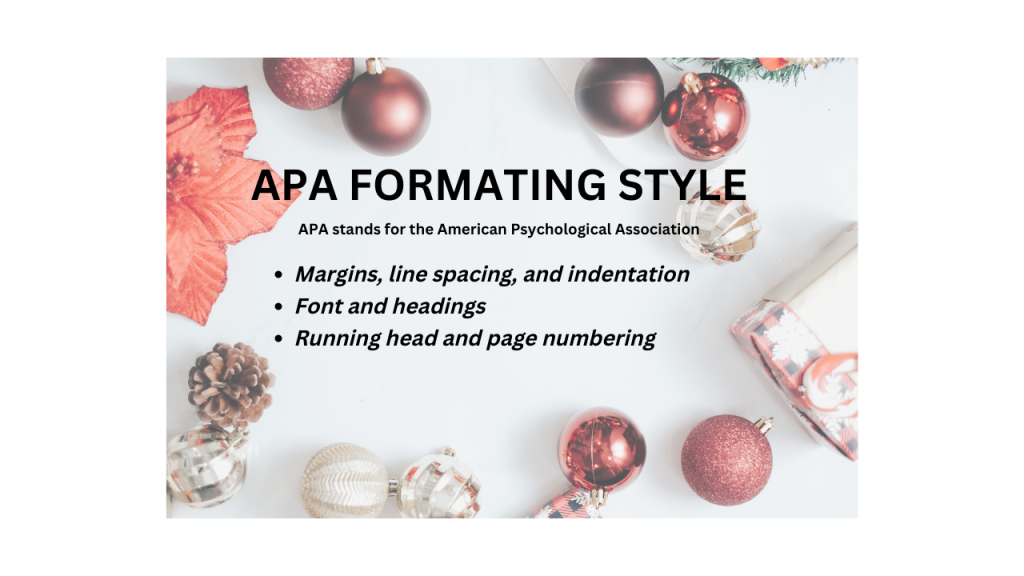
Basic APA Format
When producing a piece of literature, following a set of rules makes the structuring of the arguments simpler and improves readability. The American Psychological Association developed the APA format style as a language for use in research articles and higher education. An APA format research paper is formatted following a predetermined standard to prevent plagiarism.
To this point, if you are getting a headache understanding this concept, doesn’t worry. Online helpers from Protutor writing services are here to help you understand or even do the APA format research paper for you so you can concentrate on other areas of your course without stress!
Here Is the Basic APA Format
To get your essay to the best APA Essay format, ensure that these basic rules are followed to the end.
- Double-spacing is required for all text.
- Margins on all sides should be one inch
- The body paragraphs are all indented.
- Make sure the page’s title is in the center, followed by your name and the name of your institution.
- All text should be in 12-point font, times new roman.
- Each page must have a number in the upper right corner.
- It’s advisable to place a space after the majority of punctuation marks.
- In the upper left corner, a condensed form of the title (the “running head”) should appear.
Don’t hesitate to reach out to our online writers for help in following the above rules of APA style.
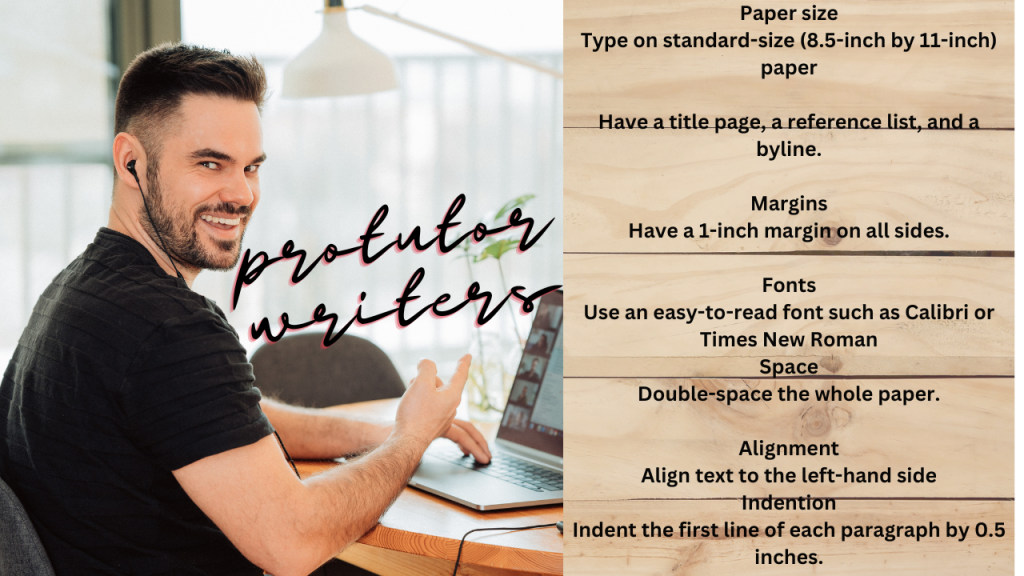
Paper Categories in APA Format
To produce an excellent APA formatted paper, you ought to understand the kind of paper you are working on. Here are some of the most common research papers you will be tackling in APA style;
Empirical Research
To produce research reports in APA style, empirical studies use data from observations and experiments. It differs from other studies because it is founded on actual data rather than hypotheses or concepts.
Review Of the Literature
These essays are written in APA format citation to evaluate a body of work or a body of works by another person. The goal is to learn more about a current issue or situation and share where we are. It clarifies problems and recommends further investigation and methodologies to close gaps.
Theoretical Articles
These online essays resemble literary reviews in that the author gathers, analyzes, and disseminates data regarding a current subject or problem by drawing on the work of others. Writing them in APA forma helps youto explain or resolve an issue by developing a novel theory. Reliable data support this theory. And using APA format citation helps you just do that.
Methodological Articles
These articles use APA format to highlight new scientific methodologies, techniques, or improvements to an established practice. The validity of the new method or method enhancement proposed by the author is supported by data or documentation.
Case Studies
Case studies use APA style provide information about a specific person, group, or broader group. These subjects are examined for a particular purpose, and you are required to discuss your research’s methodology and findings. Then you may also recommend areas for future study, develop ideas, and develop a fix for an issue.
The Usual Length of a Paper
The “less is more” philosophy applies exceptionally well to the APA format, widely used in scientific fields. Try to be as concise and straightforward as possible in expressing your ideas. Communicate in an unambiguous and businesslike manner. Don’t pad your paper with a bunch of irrelevant information. With APA format citation this method, you can keep the article concise.
APA Format Margin Requirements
Maintaining uniform left, right, top, and bottom margins is essential when writing in APA format citation. Under normal circumstances, the distance from the paper’s edge on all four sides would be the same. In APA format, each side should have a margin of at least one inch. Larger margins are fine, but nothing less than an inch is acceptable.
Pages With Titles in APA Format
The APA title page of any paper or essay should be the title page, it’s also known as the cover page in APA format style. It’s up to the individual professor or educator’s discretion whether they require an APA title page. Talk to your instructor if you are still deciding whether or not to include one. Some readers like how the page features the author’s name and the piece’s working title.
Six essential elements must be included on a student’s APA format title page, they include:
- The title of the paper,
- The names of all authors,
- The institution from which the authors hail,
- The course number and title,
- The instructor’s name,
- The due date.
Adding a running head to the title page is mandatory for academic papers but not student work.
Including an author’s note is also required by some professors and scholarly journals. An author’s message should be included after the institution’s affiliation if needed or desired. Typical components of an author’s note consist of an ID number, a disclosure, and an acknowledgment.
Writing Your Paper in APA Format.
After you are aware of the basic APA style rules that you are required to put use to create a good APA format paper, it’s time now to start writing your essay. In this section, we dig deeper into the details of what goes into what part of the paper to ensure that you score well in your final submission.
The paper’s title should convey the essay’s central idea without using acronyms or unnecessary words. If you’re writing an article about extinct dinosaurs, you could call it “dinosaurs from the Past” instead of “A Look at Extinct dinosaurs.” Don’t waste space with unnecessary words.
The APA style title should be centered and roughly three to four lines down from the top of the page.
Be sure to use a title case for the title and make it bold before setting the APA font size for the rest of the page. The title should not be italicized or underlined.
Aside from the headings, the rest of the text on the page should be simple, not bolded, underlined, or italicized.
There should be double spacing for the entire title page.
Do not use titles like “Dr.” or “Ms.” before the author’s name. Your teacher’s name, however, should be spelled in the way they like (e.g., Dan Brown, Ph.D.; Dr. Manila Aseto; Professor Nathan Ian Brown; etc.).
A writer’s institutional affiliation is the name of his alma mater or the place where they did the research.
APA style Abstract
Make a new page. In APA format it would be best if you didn’t have to add a header to your abstract page. Be sure to center and bold the word “Abstract” on the first line of the abstract page with no italics, underlining, or quotation marks.
In the line following, please provide a brief overview of the most important takeaways from your study. (Do not indent) An abstract must include the following sections:
1. Introduction,
- Purpose;
- Objectives,
2. Literature review;
- Methodology
3. Result
- Analysis,
- Interpretation.
Possible repercussions and follow-up work that could arise from your findings may also be mentioned. There should be one paragraph in your abstract, and it should be double-spaced. Most abstract guidelines recommend keeping it under 250 words. But you are free to write more, keeping in mind your professor’s instructions.
Remember when writing in APA style to Include a list of relevant keywords in your abstract. Just type Keywords: (italicized) at the start of a new paragraph and then list your keywords. Including them will facilitate the discovery of your work in databases by researchers.
Abstracts are frequently found in academic journal articles but are usually optional in student papers unless otherwise instructed. Ask your professor for guidance if you are trying to decide whether or not to include an abstract with your work.
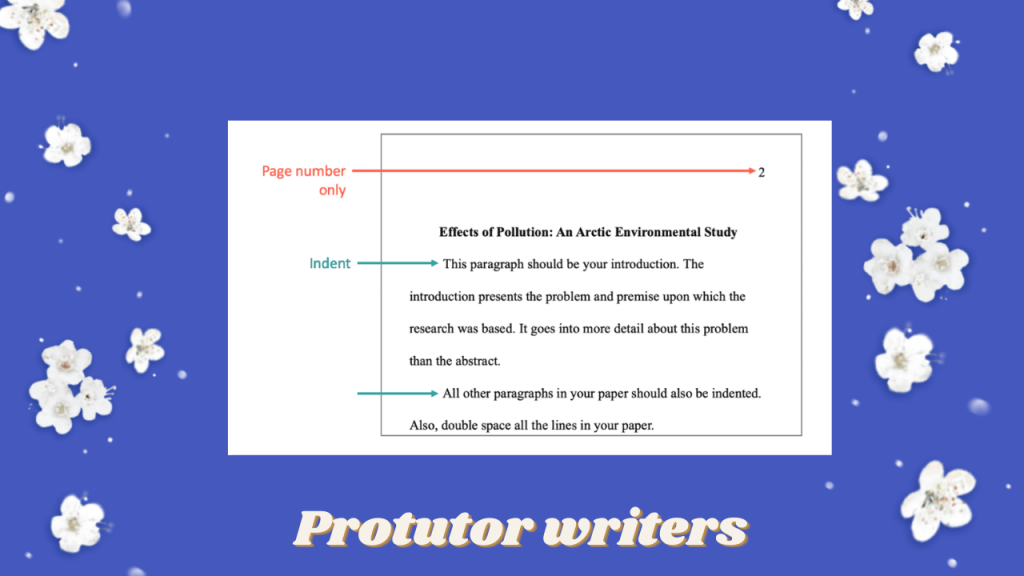
The Main Section (Body) Of an APA Paper
If you’re writing an academic paper in APA format, start the body of your essay on the page following the title page; if you’re writing a professional paper, begin with the abstract.
The standard APA paper format has to include the following:
Body Page Of Your APA Format Paper
When writing your essay body paragraphs in APA format add the page number to the upper right corner of every page, including the title page.
The title should be bold and centered on the following line. Neither italicize nor underline it.
Start with an indented first line and the introduction. Paragraphs in the main body are all spaced out evenly.
There are typically more APA style sections and rules for scientific or professional papers:
Running head (title + page number) is the first to include. It would help if you used all capital letters in the heading title. And remember, Page 2 should serve as the abstract.
The problem and premise of the study are stated in the introduction. In contrast to the abstract, it provides more context and specific examples of this issue.
The method should be used as the subheading of a new section. In all your APA format essay writing put subtitles at the center. The study’s methodology details its setup and execution. It would help if you described the procedures used to gather this information.
Your Findings
You should present the findings in a brand-new subsection. Put this subtitle in bold at the very top of the page. Finally, you sum up your data in the Results section. Do this by making graphs and charts to show the information.
The Discussion should start in a new paragraph. Put this subtitle at the center. Here in the Discussion section, you can draw conclusions about your findings.
Make inferences and explain how you arrived at them based on your data.
Discourse on whether or not the results backed up your hypothesis.
Find out what could have gone wrong with the study and what you can do to make future research even better.
Use Tables
Tables are an effective method of displaying numerous pieces of data in a manner that is at once concise, transparent, and simple to read. Statistics and other numerical data are often presented in tables in APA format papers.
Remember that tables aren’t the best format for presenting all information. Without actual numerical data, the paper’s narrative should substitute.
The Publication Manual of the (APA) American Psychological Association suggests that you create your table with the end user in mind. Make an effort to present information in a way that is straightforward and easy to grasp.
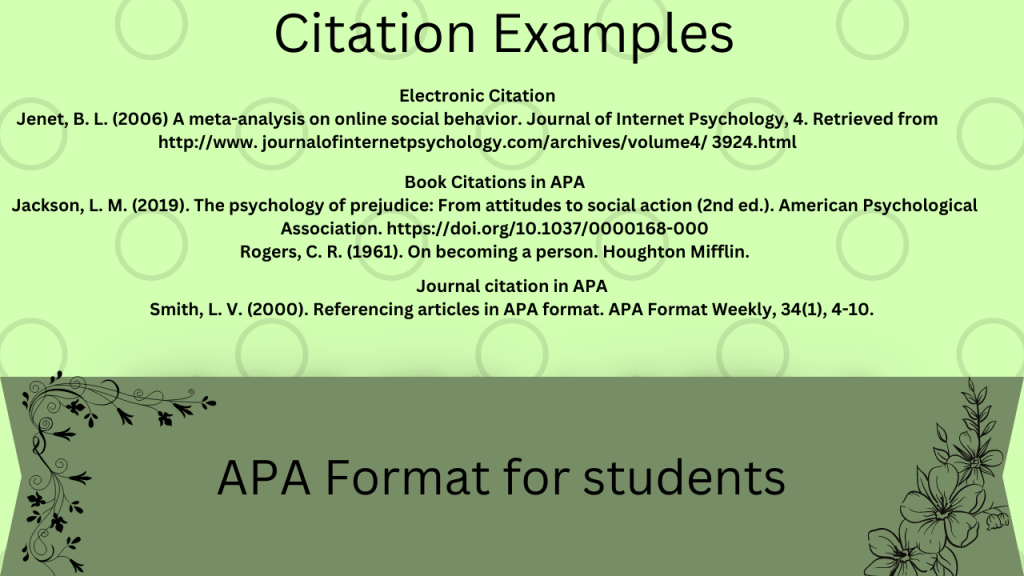
Bibliographic Citations
Your paper would only be complete with a reference page listing all the sources you used. Your APA format reference page should follow your final paragraph. By compiling your citations in one convenient location, you’ve made it simple for your reader to find the sources you’ve used.
All works cited in the text must also be listed in the reference section, and all works listed in the reference section must be cited in the text.
You should start a new page for your references and put the title “References” in bold, centered at the very top. Ensure the title is not underlined, italicized, or surrounded by quotation marks.
Simple Guidelines for Citation Pages in APA Format
The following guidelines should be kept in mind as you create your APA format reference page:
- References should be arranged alphabetically by the last names of the first authors of each work cited.
- Journal titles should be written with all major words capitalized.
- Generally, only the first letter of an article’s title should be capitalized. The first letter after the colon must also be capitalized if the title includes a colon. The title should not be italicized, underlined, or set in quotation marks to avoid confusion.
- All citations should be double-spaced.
- Publish periodicals and books in italics.
- When multiple works by the same author are referenced, the earliest should be listed first, and the most recent should be listed last.
- Each reference should have a hanging indentation, with the first line aligned to the left and subsequent lines indented.
- Magazines, Newspapers, and Other Periodicals
- References to scholarly journals should be listed in alphabetical order.
For more advice on the APA format, consider the following:
- The first letter should be capitalized when writing a title, subtitle, or proper noun.
- Include the volume number and title of the publication in italics.
- The standard format for citing a journal article is to list the authors’ last names first, followed by your initials. After the colon, you’ll see the publication year in parentheses.
- The article’s title comes next, with only the first letter of the first word and any proper nouns capitalized.
- After the comma, you’ll see the journal’s title italicized. Next, in italics, add the volume number. Afterward, put the issue number in parentheses, then a comma.
- Then, insert the page numbers, separating each range of pages with a hyphen. Please punctuate the sentence after this. Finally, a DOI number hyperlink should be included if one is available.
Books Referencing in APA Format
To properly reference a book, use the following format:
- Writer’s Last Name
- Publication date enclosed by brackets
- The book’s title, in italics
- In parentheses, if applicable, please list the book’s edition.
- the title of the publisher
- Online Identifier (DOI) Link
- Please remember to put a period after each of these details!
Electronic Citation in APA Format
Compared to the APA format of a traditional reference, the structure of an electronic one is remarkably similar. On the other hand, the URL of the document’s online home should be included.
The APA format suggests using a digital object identifier (DOI) instead of a URL whenever possible due to the instability of URLs.
There are three parts to a DOI: a prefix which is typically a four-digit number assigned to organizations. The central part of the DOI begins with a 10; and a suffix.
The DOI will often be found on many publishers’ first pages of an electronic document. To use a DOI, append it as a hypertext link at the end of the reference like this: https://doi.org/10.0000/00000000000.
If you need more guidance on citing digital resources properly, check out what’s new from the American Psychological Association. And also, our online article writers are on standby to execute your paper requirements for you.
Guidelines For Making a Table in APA Format
What could be more satisfying than perusing a beautifully formatted data table? Instead of typing out a long paragraph to explain a large amount of numerical or statistical information, consider making a table. Creating a table is a breeze in Microsoft Word or Google Docs.
The basic structure of a table is as follows:
Referring to the table’s number, write: Title, Table, Note
You can create a table to organize your information or type it all out. As was mentioned above, a table containing the same information as the text in your paper is not permitted in APA style. Pick one if you must.
Briefly mention the table in the text if you decide to use one. You could use language like, “Table 1 shows the total amount spent on Cholera control.” A more natural translation would be “Table 4 displays the incidence of stomach cancer.”
Place the table close to the section of the text in which it is first mentioned if you submit this as part of a school assignment. Most journals would rather have tables appear at the end of an article than at the beginning. We recommend asking for assistance if you still need to determine the best table location.
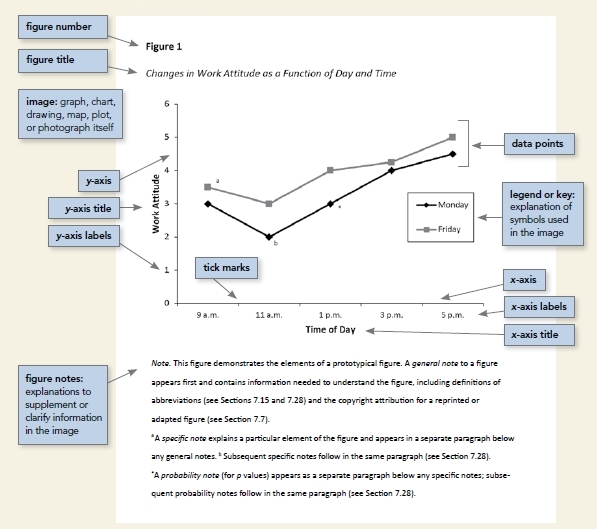
Title And Numbers in Tables in APA Format
When writing APA format style tables Remember to write the table number first and foremost. The paper begins with a discussion of Table 1, the first table in the document. The following table is Table 2, and so on. These words need to stand out more prominently.
Include a label below the digits. Make a catchy, brief, and informative title. To conform to convention, the first letter of each significant word should be capitalized.
Under the table number, put the title in italics.
In terms of layout, only horizontal lines should be used.
Reduce your reliance on cell shading.
Make sure to use a Times New Roman 12-point font and single or double spacing. If you choose to use single spacing in one table, be consistent and do so in all of the others. The key is to maintain uniformity.
In general, it’s best to center headings.
In the first column, also known as the stub, center the heading and align the content to the left (indent 0.15 inches if info is more than one line).
All other columns’ data ought to be centered.
Please include a note below the table if you need to provide additional explanation or an APA-style citation.
The note may fall into these three categories:
- General. The details of the entire table.
- Specific. Input destined for a particular column, row, or cell.
- Probability. Describes the meaning of the icons in the table—symbols like asterisks, p-values, etc.
Column Titles in APA Format
Make sure that your column titles are strictly according to the APA formatting style. To achieve this, consider the following as you craft table titles:
- Make sure to capitalize the first letter of each heading.
- Use an informative heading for each column to separate the data.
- Please make use of abbreviations for commonly used terms within the table itself. An explanation of uncommon words should be included in a footnote beneath the table.
- Employing APA format headings and subheadings Correctly
- Research papers benefit greatly from headers because they help readers quickly skim and scan for the information they need. Subsequently, headings give readers a preview of the article’s central argument before they even start reading it.
There are five distinct levels of headings in APA format style, each with its own set of formatting rules:
First Level Heading
Your paper’s working title
The title should be positioned in the page’s center.
Use boldface for the title.
When writing, it is appropriate to use both upper and lower case.
Second Level Heading
Align this heading with the left margin.
Make your boldface letters stand out.
When writing, it is appropriate to use both upper and lower case.
Third Level Heading
Third-level headings should be aligned with the left margin.
The use of italics and boldface is discouraged.
When writing, it is appropriate to use both upper and lower case.
The heading should be terminated with a period.
Fourth Level
Fourth-level indentation begins at the left margin.
Bolded
When writing, it is appropriate to use both upper and lower case.
Use a period as the final punctuation in the heading.
Fifth Level Heading
The fifth level of emphasis includes indentation, boldface, and italics.
When writing, it is appropriate to use both upper and lower case.
Stop the heading with a period.
All headings are double-spaced, and there are no extra lines or spaces between sections, per standard formatting guidelines.
Let Us Help!
At Protutor online writers, we are committed to making your essay writing as flawless as possible so you can concentrate on other aspects of your studies.
APA formatting style can be challenging at some point, and that is where we come in to help. Our online essay-writing experts will take any assignment you to give them and turn it into a high-score paper.
Contact our essay writing service today for all your formatting needs at cheap costs and with perfect results.
Needs help with similar assignment?
We are available 24x7 to deliver the best services and assignment ready within 3-4 hours? Order a custom-written, plagiarism-free paper

